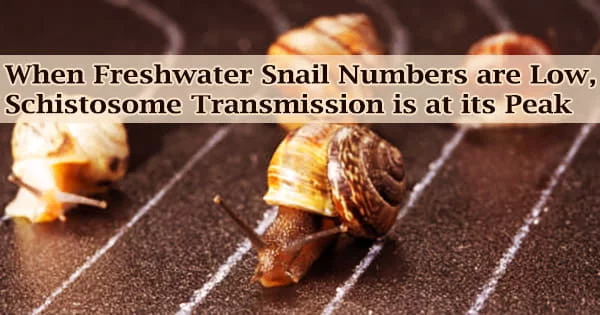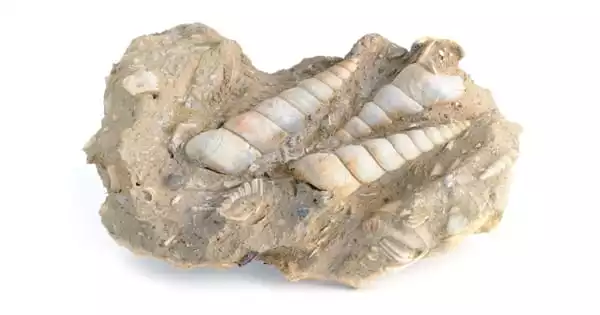Schistosomiasis is a crippling disease caused by a parasitic worm that begins its life in freshwater snails before infecting humans. One way to restrict the spread of the disease, often known as “snail fever,” is to use insecticides to kill snail populations.
According to a new study headed by Emory University, schistosome transmission is highest when freshwater snail populations are low. The work was published in the Proceedings of the National Academy of Sciences, and it was the first to show how the size of a freshwater snail population affects its parasitic infection rate.
“We’ve shown that the more snails you have in a freshwater source, the less dangerous each individual snail is, in terms of the number of parasites they’re releasing,” says David Civitello, an Emory assistant professor of biology and lead author of the study.
“The incredible strength of our finding is that we’ve demonstrated the effect both in the field, using natural transmission sites, and in an experimental context, through outdoor laboratory experiments.”
The findings have significant implications for policy aiming at minimizing schistosomiasis transmission. The parasites that cause schistosomiasis infect more than 200 million people worldwide, making it one of the most important neglected tropical diseases.
“Our results suggest that if you apply a heavy dose of pesticides to reduce a snail population, the infectivity of the remaining snails might actually skyrocket,” Civitello says. “It’s basically impossible to kill every snail and so you set the stage for a rebound in infection risk. As the snail population begins to recover, our data tells us that this is a time with extremely high potential for transmission of the parasites to humans.”
In previous laboratory trials, it was discovered that a well-fed freshwater snail infected with the parasite may produce thousands more parasites each day than an underfed snail. In fact, an infected snail that is undernourished may only produce one parasite every day.
Our results suggest that if you apply a heavy dose of pesticides to reduce a snail population, the infectivity of the remaining snails might actually skyrocket. It’s basically impossible to kill every snail and so you set the stage for a rebound in infection risk. As the snail population begins to recover, our data tells us that this is a time with extremely high potential for transmission of the parasites to humans.
David Civitello
“In general, when an animal needs to fight off an infection of some kind, it helps to have good nutrition to support the immune system,” Civitello says. “It appears to be the opposite case in these freshwater snails. When the snails are full of energy, it provides more nutrients for the parasites to steal from them and to reproduce.”
Chronic schistosomiasis infections cause significant morbidity in Sub-Saharan Africa, the Middle East, South America, and Southeast Asia. Human-freshwater snail disease cycles occur in water sources where people bathe, wash their clothing and dishes, and gather water for domestic use. Children who enjoy playing in the water are especially vulnerable to illness.
The larvae of parasitic worms burrow into snails when their eggs hatch in water. The larvae crawl back out of their snail hosts and return to the sea once they have developed into free-swimming worms. These swimming worms can then burrow into people’s skin when they come into touch with water.
As the worms mature into adults, pair up, and breed inside their human hosts, they penetrate blood arteries and consume red blood cells for fuel. Every day, the female lays hundreds of thousands of eggs.
Many of the eggs are expelled in feces and urine, which re-enters water sources and perpetuates the infection cycle. Some of the eggs, on the other hand, become trapped in their human hosts’ tissues and organs, causing immunological reactions and gradual damage to organs such as the liver, bladder, kidneys, and urogenital tract.
Blood in the urine is a hallmark indication of a persistent infection. Praziquantel, a prescription medicine for schistosomiasis, has several drawbacks.
“One problem is that the drug kills the mature adult schistosomes in humans, but not schistosomes that are only five or six weeks old and still maturing,” Civitello says.
And a follow-up drug treatment does not eliminate the infection in the environment.
“There is growing recognition in recent years that effective control of freshwater snails is needed, along with treatment of people, in order to disrupt transmission of schistosomiasis,” Civitello says. “In many cases, however, snail control policies have not been updated for decades.”
The researchers intended to explore if the effect of food consumption on the infection rate of individual freshwater snails in the lab would scale up to a community in the wild for the PNAS study.
Their theory was that as the snail population grew, the snails would have to compete for food resources more, lowering their energy levels and infectivity rate.
In partnership with Tanzania’s National Institute for Medical Study Mwanza Center, they conducted field research in the Mwanza region of Tanzania, where schistosomiasis is endemic. In the villages in the area, running water is scarce, thus many people rely on surface water ponds and hand-dug open wells dotting the clay-soil landscape.
Snails gathered from these water sources with high snail populations were shown to be less contagious, according to the researchers. In contrast, the parasite infection rate was high in water sources with a low snail population.
The outdoor laboratory tests, which were carried out in partnership with the University of South Florida, also demonstrated how increasing the density of a snail population causes a burst of infectivity before competition leads the infectivity to diminish.
“Our results suggest that, if you treat water bodies infrequently with a pesticide to control snails, you are likely to soon get a rebound of the snail population with a higher infectivity rate, potentially creating a surge of transmission to people,” Civitello. “It may be better either to not apply a pesticide at all, or else to apply the pesticide more frequently to prevent the snails rebounding.”
The Civitello lab plans to continue collaborating with Tanzanian colleagues to obtain more specific data to aid in the development of the most effective freshwater snail management approaches, which may be used in conjunction with other schistosomiasis prevention methods.
“It’s important to unite the ecology of a pathogen with human disease interventions and control measures,” Civitello says.
Co-authors of the PNAS include: Safair Kinung’hi, Teckla Angelo, Moses Mahalila, and Jenitha Charles (National Institute for Medical Research Mwanza Center); Jason Rohr (University of Notre Dame); Karena Nguyen, Rachel Hartman, Naima Starkloff and Lynda Bradley (Emory Department of Biology); Andres Manrique (University of Florida); Bryan Delius (Duquesne University); and Roger Nisbet (University of California, Santa Barbara).
The National Institute of Allergy and Infectious Diseases of the United States, the National Science Foundation, the National Institutes of Health, and the Indiana Clinical and Translational Sciences Institute all contributed to the research.
















